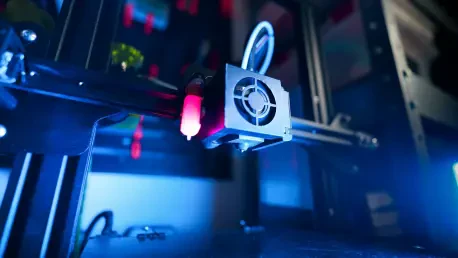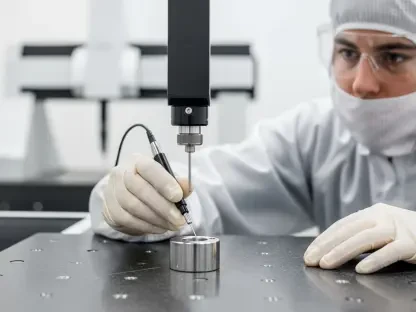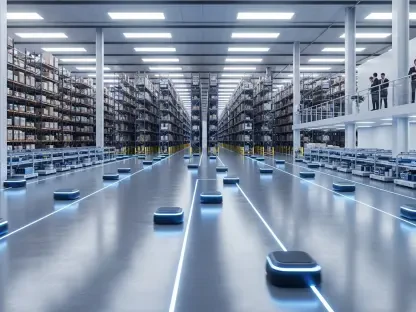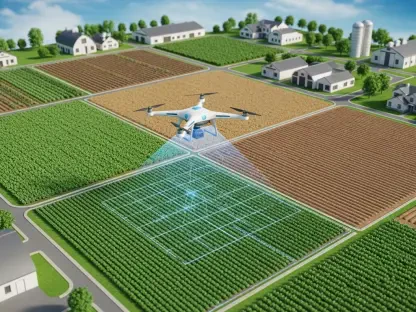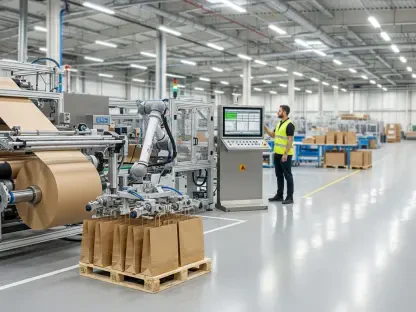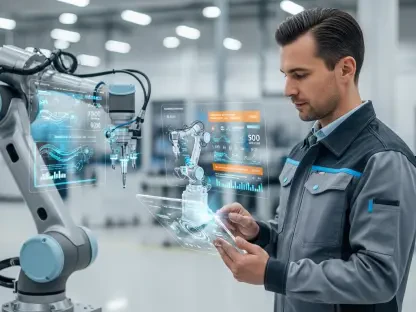Imagine stepping into a future where food products and their packaging are conceptualized, tested, and perfected in mere days, slashing both time and costs while sidestepping the pitfalls of traditional methods. This isn’t a distant dream but a tangible reality being crafted through 3D printing technology within the food and Fast-Moving Consumer Goods (FMCG) sectors. At the heart of this transformation lies the Monash Food Innovation Centre (MFI) at Monash University in Australia, where cutting-edge additive manufacturing is reshaping how agrifood businesses, from nimble startups to industry giants like Nestlé and Cadbury, bring ideas to life. Under the guidance of design and innovation manager Abhishek Banerjee, MFI harnesses tools like the Stratasys J55 PolyJet 3D printer in collaboration with Objective3D to produce high-fidelity prototypes that streamline the journey from design to market. This technology isn’t just about creating mock-ups; it’s about reimagining the entire food manufacturing process with the consumer experience as the central focus, ensuring every detail resonates before production begins.
Beyond the physical prototypes, digital innovations like virtual reality (VR) shelf visualization are integrated to simulate real-world retail environments, offering manufacturers a glimpse of how their designs compete on crowded supermarket shelves. This fusion of tangible and virtual tools is accelerating decision-making and reducing financial risks. Moreover, the decade-long partnership between MFI and Objective3D has evolved into a strategic alliance, driving technological advancements and industry education. Looking forward, the potential of 3D printing extends beyond prototyping to possibilities like mass customization and localized production, especially in dynamic markets like Australia. This article explores the multifaceted impact of 3D printing on food manufacturing, delving into its role in design efficiency, consumer engagement, and the promise of future production models that could redefine industry standards.
The Power of Prototyping with 3D Printing
Transforming Design and Development
3D printing has emerged as a pivotal force in food manufacturing by revolutionizing the prototyping phase with unparalleled speed and precision, significantly transforming how products are developed. At MFI, the Stratasys J55 printer creates detailed mock-ups, such as intricate confectionery molds for Cadbury, that can be tested directly on production lines without the exorbitant costs tied to conventional tooling. This capability significantly reduces financial risks, allowing companies to iterate designs swiftly and with confidence. The technology’s ability to produce near-final prototypes means that potential flaws or improvements can be identified early, long before substantial investments are made in full-scale manufacturing. For businesses of all sizes, this translates to a more agile innovation process where ideas can be tested and refined in real-world conditions, ensuring that the final product aligns with both technical and market expectations. The impact is clear: additive manufacturing is not just a tool but a strategic asset that de-risks the path from concept to commercialization.
Unlike traditional methods that often involve lengthy timelines and high expenses, 3D printing condenses the design cycle into a fraction of the time while maintaining exceptional quality, revolutionizing the way products are developed. The multi-material capabilities of advanced printers like the Stratasys J55 enable the creation of prototypes that closely mirror the texture, color, and form of the intended product, offering stakeholders a tangible preview of the final output. This realism is crucial for decision-making, as it allows manufacturers to assess functionality and aesthetics in a hands-on manner. Additionally, the cost-effectiveness of this approach democratizes innovation, empowering smaller enterprises to compete with larger corporations by leveling the playing field in product development. By eliminating the need for expensive molds or custom tooling in the early stages, 3D printing fosters an environment where experimentation is encouraged, and bold ideas can be explored without the fear of prohibitive costs derailing the project.
Speeding Up Market Readiness
The remarkable speed of 3D printing is a game-changer for bringing food products to market with unprecedented efficiency, as demonstrated by striking examples of innovation. A notable case comes from MFI’s work with ‘The Man Shake,’ where a lifelike bottle prototype was crafted and pitched to Woolworths, securing a store listing in an astonishing two weeks. This rapid turnaround showcases how additive manufacturing can transform a concept into a shelf-ready product almost overnight, a feat unimaginable with traditional prototyping methods. Such velocity allows companies to respond to market trends and consumer demands in real time, maintaining a competitive edge in the fast-paced FMCG sector. The ability to produce high-quality, testable designs quickly ensures that businesses can capitalize on opportunities without the delays that often plague conventional development cycles, making 3D printing an indispensable ally in achieving market readiness.
Beyond just hastening the process, the affordability of 3D printing plays a critical role in enabling this accelerated timeline, allowing manufacturers to innovate without financial strain. By minimizing the financial burden of creating multiple iterations, manufacturers can afford to test various design options without straining budgets. This is particularly beneficial for small and medium enterprises (SMEs) that may lack the resources of larger conglomerates but still aspire to innovate and grow. The technology also facilitates direct feedback loops with stakeholders, as prototypes can be produced, evaluated, and revised in quick succession, ensuring that the final product is polished and market-ready. In an industry where timing can make or break a product launch, the integration of 3D printing into the development workflow offers a strategic advantage, allowing businesses to stay ahead of competitors and meet consumer expectations with precision and speed.
Human-Centric Design at the Core
Putting Consumers First
At the core of MFI’s approach to food manufacturing innovation is a steadfast commitment to human-centric design, where the consumer’s experience drives every decision. Through 3D printing, designers can craft prototypes that prioritize how a product or its packaging feels and functions in the hands of the end-user, long before it reaches the retail shelf. This focus ensures that each element, from the ergonomics of a container to the visual appeal of a wrapper, resonates emotionally and practically with the target audience. By placing consumer needs at the forefront, the technology helps bridge the gap between abstract concepts and real-world usability, creating products that don’t just meet technical standards but also evoke a positive response. This dedication to the user journey sets a new benchmark for innovation, ensuring that market offerings are not only functional but also deeply engaging on a personal level.
The impact of this consumer-first mindset extends beyond individual products to influence broader market trends, shaping how industries respond to user needs. 3D printing allows for rapid testing of design variations tailored to specific demographics or preferences, enabling manufacturers to fine-tune their offerings based on direct feedback. For instance, a package design can be adjusted for better grip or visibility, ensuring it stands out in a competitive retail environment while meeting practical needs. This iterative process, powered by additive manufacturing, fosters a deeper understanding of consumer behavior, which in turn informs future innovations. The result is a more intuitive alignment between product design and customer expectations, reducing the likelihood of market failures. By embedding human-centric principles into the prototyping phase, 3D printing helps ensure that every new food item or package isn’t just a commodity but a solution crafted with the end-user’s daily life in mind.
Crafting Emotional Connections
Human-centric design facilitated by 3D printing goes beyond mere functionality to create emotional connections with consumers. The technology enables the production of prototypes that capture the sensory and aesthetic qualities of a final product, allowing designers to test how a candy bar’s wrapper color or a bottle’s shape evokes specific feelings or brand associations. This attention to detail ensures that products not only serve a purpose but also build a rapport with users, fostering loyalty in a crowded marketplace. At MFI, this approach is evident in every project, as the team meticulously refines designs to align with the subtle cues that influence purchasing decisions, turning ordinary items into memorable experiences for shoppers.
Moreover, the ability to prototype with such precision empowers brands to tell compelling stories through their products. A well-designed package, tested and perfected via 3D printing, can convey a narrative of quality or sustainability that resonates with today’s conscious consumers. This storytelling aspect is vital in differentiating products in an era where emotional engagement often outweighs price or convenience in decision-making. The technology also allows for quick adjustments based on cultural or regional preferences, ensuring that designs are relevant across diverse markets. By focusing on these nuanced aspects of consumer interaction, 3D printing supports the creation of food products and packaging that don’t just meet needs but also inspire delight and trust, reinforcing the importance of emotional design in modern manufacturing.
Bridging Physical and Digital Innovation
Enhancing Decisions with Virtual Tools
Complementing the physical prototypes produced through 3D printing, MFI employs virtual reality (VR) shelf visualization to provide manufacturers with a dynamic view of how their designs perform in simulated retail environments. This digital tool allows companies to place their packaging alongside competitors on virtual supermarket shelves, offering critical insights into visibility and appeal without the expense of real-world testing. Such simulations reveal whether a product stands out or gets lost in the clutter, enabling designers to tweak elements like color or shape for maximum impact. The synergy between tangible 3D-printed models and VR technology creates a comprehensive framework for validating design choices, ensuring that products are not only well-crafted in isolation but also competitive in the context of a bustling store setting, ultimately enhancing strategic decision-making.
The integration of digital tools like VR with physical prototyping also streamlines the feedback process, allowing stakeholders to make informed adjustments with minimal delay. Manufacturers can observe consumer interactions in a virtual space, identifying potential pain points or missed opportunities before committing to production. This approach reduces the risk of costly redesigns or market missteps by providing a realistic preview of a product’s retail performance. Furthermore, it supports collaboration among teams, as digital simulations can be shared and reviewed remotely, fostering consensus on design direction. By bridging the gap between the physical and the virtual, this combined methodology ensures that innovations are thoroughly vetted from multiple angles, offering a robust foundation for bringing food products to market with confidence and precision.
Simulating Real-World Impact
The use of VR shelf visualization alongside 3D printing offers a unique opportunity to simulate the real-world impact of food packaging and product designs before they ever reach consumers. This technology replicates the chaos of a supermarket aisle, complete with competing brands and varying shelf placements, to assess how a new design captures attention or influences purchasing behavior. Manufacturers gain actionable data on whether a bold logo or a unique shape draws the eye amidst a sea of alternatives, allowing for targeted refinements. This preemptive analysis is invaluable in a sector where first impressions often dictate success, ensuring that products are optimized for visibility and appeal long before they face actual shoppers, thus minimizing the guesswork in retail strategy.
Additionally, this digital-physical hybrid approach aids in predicting consumer trends by testing multiple scenarios within a virtual space. Different demographics or regional preferences can be modeled to see how a design resonates across varied audiences, providing insights that guide broader marketing and distribution plans. This predictive capability, paired with the tactile feedback from 3D-printed prototypes, creates a holistic evaluation process that balances aesthetics with practicality. The result is a more informed launch strategy that anticipates market reception and mitigates risks of poor performance. By simulating real-world conditions with such accuracy, the combination of VR and additive manufacturing equips food businesses with the foresight needed to navigate the complexities of modern retail, setting a new standard for innovation readiness.
Strategic Partnerships Fueling Progress
A Decade of Collaboration
The transformative strides in food manufacturing through 3D printing at MFI are underpinned by a decade-long partnership with Objective3D, an Australian leader in additive manufacturing solutions. What began as a straightforward supplier-client relationship has blossomed into a strategic alliance, marked by joint investments such as the co-purchase of the Stratasys J55 printer. This collaboration extends beyond equipment to include training and technical support, positioning MFI as a hub for executive education on cutting-edge technologies. The shared commitment to advancing industry capabilities ensures that both entities remain at the forefront of innovation, providing agrifood businesses with access to tools and expertise that drive meaningful progress in product development and design efficiency.
This partnership also serves as a model for how academia and industry can unite to tackle real-world challenges in food manufacturing. By pooling resources and knowledge, MFI and Objective3D have created an ecosystem where technological advancements are not just adopted but also adapted to meet specific sector needs. The focus on education through workshops and training programs further amplifies this impact, equipping professionals with the skills to leverage 3D printing effectively. This collaborative spirit fosters a culture of continuous improvement, where feedback from practical applications informs future innovations. As a result, the alliance not only enhances MFI’s operational excellence but also sets a precedent for how strategic relationships can accelerate the adoption of transformative technologies across the broader FMCG landscape.
Building Industry-Wide Innovation
The collaboration between MFI and Objective3D extends its influence beyond individual projects to catalyze industry-wide innovation in food manufacturing. By sharing access to state-of-the-art 3D printing technology and fostering a knowledge exchange, this partnership empowers a diverse range of companies—from startups to global brands—to explore new possibilities in product and packaging design. The ripple effect is evident as more businesses adopt additive manufacturing, inspired by the success stories emerging from MFI’s initiatives. This collective push toward modernization helps standardize the use of advanced tools across the sector, raising the bar for quality and efficiency while encouraging a competitive yet collaborative environment focused on consumer benefit.
Moreover, the emphasis on training and support within this alliance ensures that the benefits of 3D printing are not confined to a select few but are accessible to a wider audience of industry players. Objective3D’s technical expertise complements MFI’s research-driven approach, creating a robust support system that helps companies navigate the complexities of integrating new technologies into existing workflows. This democratization of innovation sparks a broader cultural shift, where experimentation with additive manufacturing becomes a norm rather than an exception. The long-term impact is a more resilient and adaptable food manufacturing sector, capable of meeting evolving market demands with creativity and precision, thanks to the foundational work of such strategic partnerships.
The Future of 3D Printing in Food Manufacturing
Beyond Prototyping to Production
Looking ahead, the role of 3D printing in food manufacturing is set to expand far beyond prototyping into the realm of actual production. Abhishek Banerjee envisions a future where additive manufacturing mirrors its success in industries like metal parts, becoming a viable method for creating food products on a larger scale. This shift could usher in an era of mass customization, where items are tailored to individual consumer preferences without the inefficiencies of traditional mass production. Particularly in fast-paced markets like Australia, the ability to produce on-demand, localized solutions offers a significant edge, reducing supply chain delays and enhancing responsiveness to regional tastes. Such a transformation promises to redefine manufacturing paradigms, making flexibility and personalization key pillars of future food production strategies.
The potential for 3D printing to evolve into a mainstream production tool also brings with it the promise of sustainability, especially as it transforms various industries. By enabling localized manufacturing, the technology could minimize transportation costs and carbon footprints associated with global supply chains. Additionally, the precision of additive manufacturing reduces material waste, as products are built layer by layer with exact specifications, unlike subtractive methods that discard excess. This aligns with growing consumer and regulatory demands for eco-friendly practices in the food sector. As the technology matures, investments in scalable 3D printing systems could further drive down costs, making it feasible for even smaller businesses to adopt production-level solutions. The journey from prototyping to production represents a bold frontier, one that could fundamentally alter how food is made and delivered to consumers worldwide.
Redefining Industry Standards
As 3D printing continues to advance, it stands poised to redefine the very standards of the food manufacturing industry. The technology’s capacity to support bespoke designs tailored to niche consumer needs allows for unprecedented personalization, catering to specific dietary requirements or cultural preferences with ease. This shift challenges the one-size-fits-all model of traditional production, paving the way for smaller, more flexible runs that prioritize quality over sheer volume. Such adaptability ensures that manufacturers can swiftly pivot to meet emerging trends or sudden shifts in demand, maintaining relevance in a dynamic market. The implications are profound, as 3D printing could set new benchmarks for what constitutes innovation and efficiency in food production.
Furthermore, the integration of 3D printing into mainstream manufacturing is likely to spur regulatory and technological advancements that further solidify its role. As more companies adopt this method, standardized protocols for safety, quality, and scalability will emerge, ensuring consistency across applications. This evolution will also encourage cross-industry learning, where insights from sectors like aerospace or healthcare, already leveraging additive manufacturing, inform food production techniques. The result is a future where 3D printing not only enhances individual product lines but also transforms the structural framework of the industry, embedding agility and consumer-centricity into its core. By pushing these boundaries, the technology promises a landscape where food manufacturing is as much about creativity and customization as it is about meeting basic needs.
